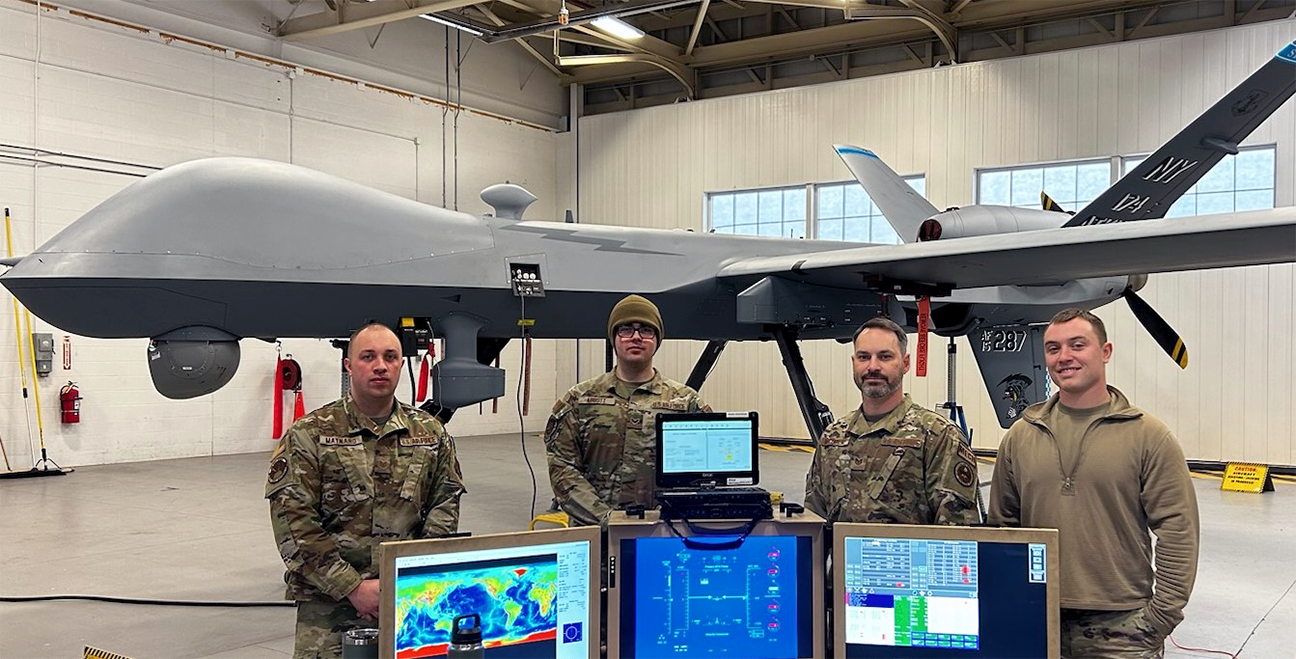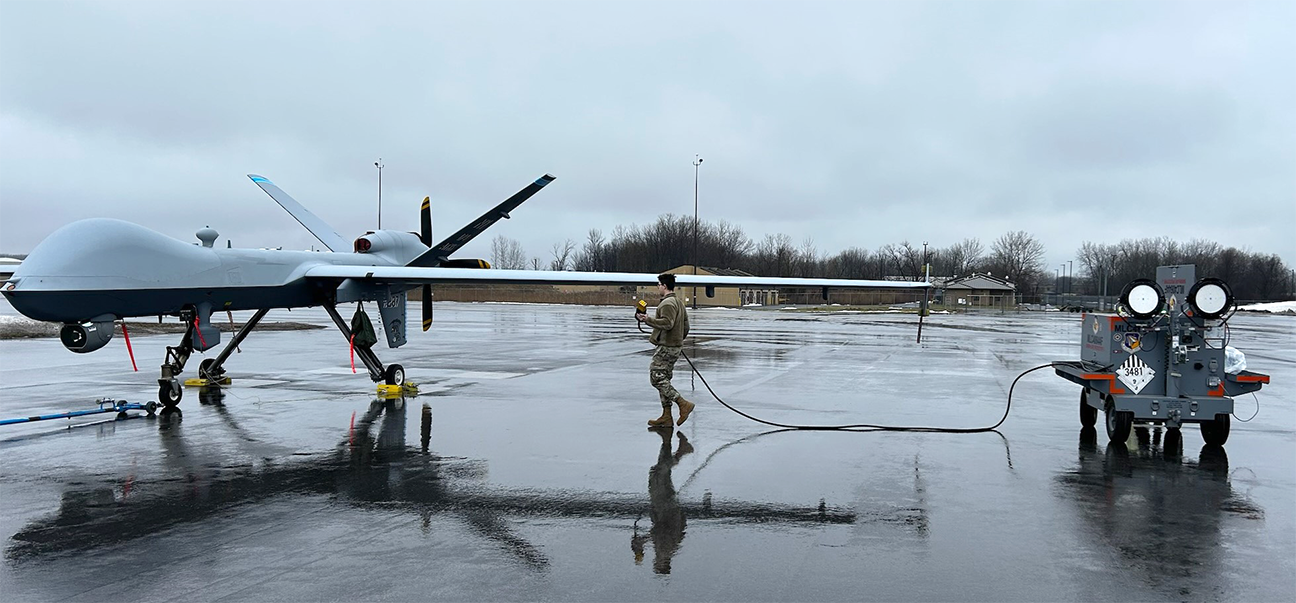HANCOCK FIELD AIR NATIONAL GUARD BASE, NY — The Department of the Air Force, or DAF, completed testing of the 400Hz Aircraft Power Lightcart, or 400 APL in January 2024. The tests, which were conducted with the 174th Attack Wing at Hancock Field Air National Guard Base in Syracuse, New York, saw the prototype successfully power an MQ-9, or Predator, through a series of technical orders.

The Department of the Air Force recently successfully tested the 400 Hz Aircraft Power Lightcart, or 400 APL prototype. The tests, which were conducted at the 174th Attack Wing at Hancock Field Air National Guard Base in Syracuse, New York, saw the 400 APL prototype successfully power an MQ-9 or Predator through a series of technical orders.
The 400 APL project, which was led by the Air Force Research Laboratory’s, or AFRL’s, Energy Office, promotes the U.S. Air Force’s push toward the Agile Combat Employment, or ACE concept, which is to disperse aircraft and equipment between major hub bases and smaller airfields to improve resilience and survivability. ACE operations require aircraft, Airmen and equipment to rapidly relocate to the combat edge and generate combat sorties. Small, light, multi-capable equipment is critical to reducing logistics demands and increasing combat tempo and agility.
The 400 APL provides an efficient power and light source that is 4,500 pounds lighter than the combined weight of the two pieces of equipment it will replace, the B809 generator and the MLC4064AF lightcart. This translates to an overall reduction in the system logistics footprint and fuel consumption.
“Support for this program has been off the charts,” said Tom Layne, project team lead and engineer at the AFRL Energy Office. “The requirement jointly came in from Air Force Global Strike Command and Air Force Special Operations Command, for programming weapons and powering small airframes on the ground. The prime contractor was Concurrent Technologies Corporation with design inputs coming from Pacific Air Forces, Air Combat Command, Air Force Special Operations Command, Air National Guard, Air Force Materiel Command (AFMC)/A4M, and three program offices: Support Equipment & Vehicles, Automatic Test Systems, and MQ-9.”
Lt. Col. Lee Nietzel, Aircraft Maintenance Squadron commander for the 174th Attack Wing, said he was thrilled with the successful test and the part that the 400 APL would play in the ability to set up rapid launch and recovery sites.

Crew chiefs assigned to the successful of the testing of the 400 Hz Aircraft Power Lightcart, or 400 APL prototype, noted added benefit of reduced noise and emissions which improved their ability to perform their mission. The tests, which were conducted at the MQ-9 174th Attack Wing at Hancock Field Air National Guard Base, Syracuse, New York, saw the 400 APL prototype successfully power an MQ-9 or Predator through a series of technical orders.
“Our Aircraft Maintenance Squadron’s capability to be agile resides with reducing and simplifying our equipment footprint,” said Nietzel. “Being agile means less equipment, less weight, and quicker mobilization at a launch and recovery site. Our goal is a single C-130 to setup a rapid launch and recovery site. The APL cart helps get us to our goal by replacing two pieces of equipment with one, in turn a [nearly] 5,000-pound reduction in weight and one pallet position. We look forward to future testing of APL with our newly acquired Reaper Rapid Reaction Trailer, which will improve the speed of our mobilization at a launch and recovery site.”
Senior Master Sgt. Michael Thayer, Aerospace Ground Equipment lead at headquarters Air Force Materiel Command, or AFMC, Aircraft Maintenance Division, who also participated in the testing, said he was impressed with the prototype.
“The 400 APL has the potential to be a game-changer,” Thayer said. “Its multi-capable design includes aircraft and convenience power with LED lighting during low-light operations. It also has reduced maintenance requirements. It’s a perfect right-sized unit for future mobility requirements.”
Lt. Col. Van Nostrand, deputy chief of the Support Equipment and Vehicle Program Office, has been a driving force to both right-size and modernize flightline equipment.
“In parallel with this prototype effort, the Support Equipment and Vehicle Division is working with our Air Force-wide partners and making a hard push to define aircraft platform combat minimum technical requirements to enable right-sized solutions such as this prototype power cart to be used in more places to reduce the USAF Aircraft Support footprint and increase USAF agile operations,” Van Nostrand said.
The team is currently working on an even more capable variant of the 400 APL that will be able to provide power to larger combat airframes in ACE operations, such as the F-15, Layne said. This enhanced capability prototype is scheduled to begin testing later in 2024.

An aircraft maintainer at the 174th Attack Wing at Hancock Field Air National Guard Base, Syracuse, New York, connects the power cable from the 400 Hz Aircraft Power Lightcart, or 400 APL prototype to an MQ-9, or Predator to test its ability to power the aircraft through a series of technical orders on the flightline.
About AFRL
The Air Force Research Laboratory is the primary scientific research and development center for the Department of the Air Force. AFRL plays an integral role in leading the discovery, development, and integration of affordable warfighting technologies for our air, space and cyberspace force. With a workforce of more than 12,500 across nine technology areas and 40 other operations across the globe, AFRL provides a diverse portfolio of science and technology ranging from fundamental to advanced research and technology development. For more information, visit www.afresearchlab.com.

